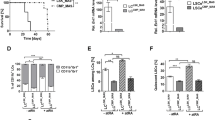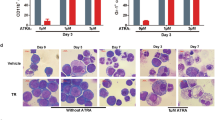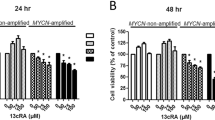Abstract
Excessive expression of tissue factor (TF) is a common finding in leukaemic cells and may contribute to thrombotic complications in patients. Retinoic acid has been shown to induce differentiation and reduce TF expression in acute promyelocytic leukaemia (APL) cells in vitro, and to induce remission in APL patients. Treatment of the APL cell line NB4 with the specific retinoic acid receptor-α (RARα) agonists Ro40–6055 or TTNPB resulted in down-regulation of TF expression and in induction of differentiation. The activation of RARβ, RARγ or retinoid X receptor (RXR) did not suppress the constitutive TF expression in NB4 cells. Moreover, the RARα antagonist Ro41-5253 blocked the retinoid-induced down-regulation of TF. In contrast, in the monoblastic U-937 cell line only a partial suppression of TF antigen expression and activity was observed by treatment with the RAR agonist TTNPB or the RXR agonist SR11237 alone. However, the combination of TTNPB and SR11237 resulted in a pronounced down-regulation of TF expression and induction of differentiation in U-937 cells. We show for the first time that the activation of both subunits of the RARα-RXR transcriptional complex is needed for TF suppression in U-937 cells, whereas in NB4 cells RARα activation alone is sufficient. Thus, distinct molecular mechanisms for TF suppression seem to be operating in leukaemic cell lines of different origin.
This is a preview of subscription content, access via your institution
Access options
Subscribe to this journal
Receive 12 print issues and online access
$259.00 per year
only $21.58 per issue
Buy this article
- Purchase on Springer Link
- Instant access to full article PDF
Prices may be subject to local taxes which are calculated during checkout




Similar content being viewed by others
References
Semeraro N, Colucci M . Tissue factor in health and disease Thromb Haemost 1997 78: 759–764
Brozna JP . Cellular regulation of tissue factor Blood Coagul Fibrinolysis 1990 1: 415–426
Østerud B, Flaegstad T . Increased tissue thromboplastin activity in monocytes of patients with meningococcal infection: related to an unfavourable prognosis Thromb Haemost 1983 49: 5–7
Asakura H, Kamikubo Y, Goto A, Shiratori Y, Yamazaki M, Jokaji H, Saito M, Uotani C, Kumabashiri I, Morishita E, Aoshima K, Nakamura S, Matsuda T . Role of tissue factor in disseminated intravascular coagulation Thromb Res 1995 80: 217–224
Andoh K, Kubota T, Takada M, Tanaka H, Kobayashi N, Maekawa T . Tissue factor activity in leukemia cells: special reference to disseminated intravascular coagulation Cancer 1987 59: 748–754
Stephens AC, Zheng RQ, Russell AR, Levin M, Rivers RP . Production of tissue factor by monocyte progenitor cells Thromb Res 1994 76: 33–45
Breitman TR, Selonick SE, Collins SJ . Induction of differentiation of the human promyelocytic leukemia cell line (HL-60) by retinoic acid Proc Natl Acad Sci USA 1980 77: 2936–2940
Olsson IL, Breitman TR . Induction of differentiation of the human histiocytic lymphoma cell line U-937 by retinoic acid and cyclic adenosine 3′:5′-monophosphate-inducing agents Cancer Res 1982 42: 3924–3927
Koyama T, Hirosawa S, Kawamata N, Tohda S, Aoki N . All-trans retinoic acid upregulates thrombomodulin and downregulates tissue-factor expression in acute promyelocytic leukemia cells: distinct expression of thrombomodulin and tissue factor in human leukemic cells Blood 1994 84: 3001–3009
Saito T, Koyama T, Nagata K, Kamiyama R, Hirosawa S . Anticoagulant effects of retinoic acids on leukemia cells Blood 1996 87: 657–665
Tenno T, Öberg F, Nilsson K, Siegbahn A . Induction of differentiation in U-937 and NB4 cells is associated with inhibition of tissue factor production Eur J Haematol 1999 63: 112–119
Barbui T, Finazzi G, Falanga A . The impact of all-trans retinoic acid on the coagulopathy of acute promyelocytic leukemia Blood 1998 91: 3093–3102
Mangelsdorf DJ, Evans RM . The RXR heterodimers and orphan receptors Cell 1995 83: 841–850
Botling J, Castro DS, Öberg F, Nilsson K, Perlmann T . Retinoic acid receptor/retinoid X receptor heterodimers can be activated through both subunits providing a basis for synergistic transactivation and cellular differentiation J Biol Chem 1997 272: 9443–9449
Brooks SC, Kazmer S, Levin AA, Yen A . Myeloid differentiation and retinoblastoma phosphorylation changes in HL-60 cells induced by retinoic acid receptor- and retinoid X receptor-selective retinoic acid analogs Blood 1996 87: 227–237
Melnick A, Licht JD . Deconstructing a disease: RARα, its fusion partners, and their roles in the pathogenesis of acute promyelocytic leukemia Blood 1999 93: 3167–3215
Shibakura M, Koyama T, Saito T, Shudo K, Miyasaka N, Kamiyama R, Hirosawa S . Anticoagulant effects of synthetic retinoids mediated via different receptors on human leukemia and umbilical vein endothelial cells Blood 1997 90: 1545–1551
Falanga A, Consonni R, Marchetti M, Locatelli G, Garattini E, Passerini CG, Gordon SG, Barbui T . Cancer procoagulant and tissue factor are differently modulated by all-trans retinoic acid in acute promyelocytic leukemia cells Blood 1998 92: 143–151
Lanotte M, Martin-Thouvenin V, Najman S, Balerini P, Valensi F, Berger R . NB4, a maturation inducible cell line with t(15;17) marker isolated from a human acute promyelocytic leukemia (M3) Blood 1991 77: 1080–1086
Sundström C, Nilsson K . Establishment and characterization of a human histocytic lymphoma cell line (U-937) Int J Cancer 1976 17: 565–577
Åsjö B, Ihved I, Gidlund M, Fuerstenberg S, Fenyö EM, Nilsson K, Wigzell H . Susceptibility to infection by the human immunodeficiency virus (HIV) correlates with T4 expression in a parential monocytoid cell line and its subclones Virology 1987 157: 359–365
Heid CA, Stevens J, Livak KJ, Williams PM . Real time quantitative PCR Genome Res 1996 6: 986–994
Lindmark E, Tenno T, Chen J, Siegbahn A . IL-10 inhibits LPS-induced human monocyte tissue factor expression in whole blood Br J Haematol 1998 102: 597–604
Lehmann JM, Jong L, Fanjul A, Cameron JF, Lu XP, Haefner P, Dawson MI, Pfahl M . Retinoids selective for retinoid X receptor response pathways Science 1992 258: 1944–1946
Falanga A, Alessio MG, Donati MB, Barbui T . A new procoagulant in acute leukemia Blood 1988 71: 870–875
Bollag W, Isnardi L, Jablonska S, Klaus M, Majewski S, Pirson W, Toma S . Links between pharmacological properties of retinoids and nuclear retinoid receptors Int J Cancer 1997 70: 470–472
Tenno T, Botling J, Öberg F, Nilsson K, Siegbahn A . Tissue factor expression in human monocytic cell lines Thromb Res 1997 88: 215–228
James SY, Williams MA, Newland AC, Colston KW . Leukemia cell differentiation: cellular and molecular interactions of retinoids and vitamin D Gen Pharmacol 1999 32: 143–154
Tallman MS, Hakimian D, Kwaan HC, Rickles FR . New insights into the pathogenesis of coagulation dysfunction in acute promyelocytic leukemia Leuk Lymphoma 1993 11: 27–36
Shibakura M, Koyama T, Ohsawa M, Kamiyama R, Hirosawa S . A retinoic acid receptor-α (RARα) selective agonist modulates procoagulant activity of acute promyelocytic cells and induces their differentiation into neutrophils Blood 1998 91: 724–725
Chen JY, Clifford J, Zusi C, Starrett J, Tortolani D, Ostrowski J, Reczek PR, Chambon P, Gronemeyer H . Two distinct actions of retinoid-receptor ligands Nature 1996 382: 819–822
Brooks SC, Sturgill R, Choi J, Yen A . An RXR-selective analog attenuates the RARα-selective analog-induced differentiation and non-G1-restricted growth arrest of NB4 cells Exp Cell Res 1997 234: 259–269
Botling J, Öberg F, Törmä H, Tuohimaa P, Bläuer M, Nilsson K . Vitamin D3- and retinoic acid-induced monocytic differentiation: interactions between the endogenous vitamin D3 receptor, retinoic acid receptors, and retinoid X receptors in U-937 cells Cell Growth Differ 1996 7: 1239–1249
Chambon P . A decade of molecular biology of retinoic acid receptors FASEB J 1996 10: 940–954
Hong SH, David G, Wong CW, Dejean A, Privalsky ML . SMRT corepressor interacts with PLZF and with the PML-retinoic acid receptor α (RARα) and PLZF-RARα oncoproteins associated with acute promyelocytic leukemia Proc Natl Acad Sci USA 1997 94: 9028–9033
Yoshida H, Kitamura K, Tanaka K, Omura S, Miyazaki T, Hachiya T, Ohno R, Naoe T . Accelerated degradation of PML-retinoic acid receptor α (PML-RARα) oncoprotein by all-trans retinoic acid in acute promyelocytic leukemia: possible role of the proteasome pathway Cancer Res 1996 56: 2945–2948
Benoit G, Altucci L, Flexor M, Ruchaud S, Lillehaug J, Raffelsberger W, Gronemeyer H, Lanotte M . RAR-independent RXR signaling induces t(15;17) leukemia cell maturation EMBO J 1999 18: 7011–7018
Apfel CM, Kamber M, Klaus M, Mohr P, Keidel S, LeMotte PK . Enhancement of HL-60 differentiation by a new class of retinoids with selective activity on retinoid X receptor J Biol Chem 1995 270: 30765–30772
Boehm MF, McClurg MR, Pathirana C, Mangelsdorf D, White SK, Hebert J, Winn D, Goldman ME, Heyman RA . Synthesis of high specific activity [3H]-9-cis-retinoic acid and its application for identifying retinoids with unusual binding properties J Med Chem 1994 37: 408–414
Apfel C, Bauer F, Crettaz M, Forni L, Kamber M, Kaufmann F, LeMotte P, Pirson W, Klaus M . A retinoic acid receptor α antagonist selectively counteracts retinoic acid effects Proc Natl Acad Sci USA 1992 89: 7129–7133
Acknowledgements
This study was supported by the Swedish Cancer Society. We thank Michael Klaus (Hoffmann-La Roche, Basel, Switzerland) for providing us the nuclear receptor ligands and Inger Karlberg for skilful technical assistance.
Author information
Authors and Affiliations
Rights and permissions
About this article
Cite this article
Tenno, T., Botling, J., Öberg, F. et al. The role of RAR and RXR activation in retinoid-induced tissue factor suppression. Leukemia 14, 1105–1111 (2000). https://doi.org/10.1038/sj.leu.2401785
Received:
Accepted:
Published:
Issue Date:
DOI: https://doi.org/10.1038/sj.leu.2401785



